- Thu Jan 10, 2019 6:59 pm
#328016
Black Sarracenia have been in the cross hairs of breeders for a long time now, but few have succeeded in creating such a beast. Granted, there are a few Sarracenia out there that do turn black with an "artificial suntan" aka when greenhouse grown, but has anyone made a plant that turns black from head to toe without the need of a greenhouse?
It's definitely not easy to make such a plant, the reason being that most of the black clones/genetics in cultivation are difficult to coax that color out of them. They really need the exact right conditions to darken up! Sure, they will get black when grown under powerful lights indoors or under greenhouse conditions, but outdoors, they merely get dark. Here's a good example of a black alata that gets dark under my outdoor conditions, but not black. This is S. alata dark 'upward lid' Stone Co, MS:

In the wild, they definitely can get pretty dark as the traps age, but you don't see such a high frequency of dark alatas in cultivation. As an aside, I've bred with many "proven" black alata clones only to find the offpsring are generally not as impressive. Some selfed plants (ie. selfed alata 'Night') looked quite impressive greenhouse grown, but they still don't color up easily outdoors. Anyways, the pics below are from wild plants growing in Stone Co, MS:


Previously, the closest thing I've personally grown that gets really dark without a greenhouse suntan is Phil's Faulisi's Black Widow:

Honorable mention shout out to Rob Sacilotto's S. 'Tornado'(aka S. 'Vortex') There are also pictures online of some black flava x alata crosses made by insektenfang.com, but since the pictures are clearly copyrighted, I'm not going to copy them in this thread. That hybrid appears to have a very black head, but the body is dark red. I'm very confident these were greenhouse grown plants, and they appear to be as dark as some of the black alatas grown under greenhouse conditions.
For those of us without greenhouses, are there any individual plants out there that turn black even under outdoor conditions? I'm not aware of any non-man made plants like that.
Logically, there has to be a way to make a completely black plant from head to toe using flava rubricorpora and the dark alatas, so that's what I did. Black widow is really cool, but I want blacker! LOL
I made several small batch crosses with many different clones in search of that black individual. By small batch, I mean I sowed between 30-50 or so seeds per batch. Surprisingly, most were duds: while the plants were pretty and many were bright red, none were black, so I tossed every last cross out. In one cross, I did get a few darker indivduals, but not darker than black widow. GAH!!!! Phil either got lucky or did a lot of pheno hunting to find black widow. Anyways, Next thought was, what if I grew out over a 1000 seeds, will that one black individual appear? Those black genes have to be there somewhere, maybe it's just a numbers game. But it's not practical to grow out 1000 of each cross, that could take up a lot of space very quickly and become impractical.
I decided to focus on one cross that had dark individuals and re-made it the following year, producing an enormous seed batch. If a few dark ones showed up in 50 seeds or less, will that one black one show up in 1000?
It was a ridiculous amount of work transplanting seedlings and culling lighter colored individuals. No, I didn't grow them all the way out (don't have space and time for that), I did massive cullings and selected out the darkest ones.
With a combination of an educated guess and the power of numbers, I finally found that one individual that I was looking for! Interestingly, NOT A SINGLE OTHER PLANT in the super sized seedling batch was as dark as this individual! There were some that I suspect could probably get blacker with an artificial suntan, but I was looking for the one that gets black under multiple environmental conditions. There were other individuals that came close in terms of blackness, but I culled them to make sure imposters don't go into circulation. Speaking of imposters, this is the reason that I'm not giving out exact details about the clones used in this cross, but in general, flava rubricorpora and alata were used, just like in Phil's black widow cross.
Perhaps the beans are being spilled quite early as this plant is still a seedling, but after you see the pics below, you'll probably agree that this individual is already outstanding. In case you haven't already read this thread about seedling selection and want to dig deeper, I recommend reading this: http://sarracenia.proboards.com/thread/ ... -selection
This un-named clone below doesn't start off black: the traps really have to age before it gets to this color. This plant was naturally grown outdoors in Northern California, and quite possibly represents one of the first of its kind that can get black from head to toe without an artificial greenhouse suntan:

In case you want to zoom in to see the details of the pic above: https://www.flickr.com/photos/63000221@ ... ateposted/

and if you want to zoom in: https://www.flickr.com/photos/63000221@ ... otostream/
The whole dang thing is black:

Another shot: notice some of the younger, smaller traps still have some greenish pigments on the lid:


In case you want a close up of that last pic: https://www.flickr.com/photos/63000221@ ... otostream/
This is still a seedling, so again, I may be spilling the beans a bit early about it. For this reason, it won't be named or go into circulation until it reaches vegetative maturity and has been throughly "explored." Who knows, something better might turn up in the meantime. To be continued....
It's definitely not easy to make such a plant, the reason being that most of the black clones/genetics in cultivation are difficult to coax that color out of them. They really need the exact right conditions to darken up! Sure, they will get black when grown under powerful lights indoors or under greenhouse conditions, but outdoors, they merely get dark. Here's a good example of a black alata that gets dark under my outdoor conditions, but not black. This is S. alata dark 'upward lid' Stone Co, MS:
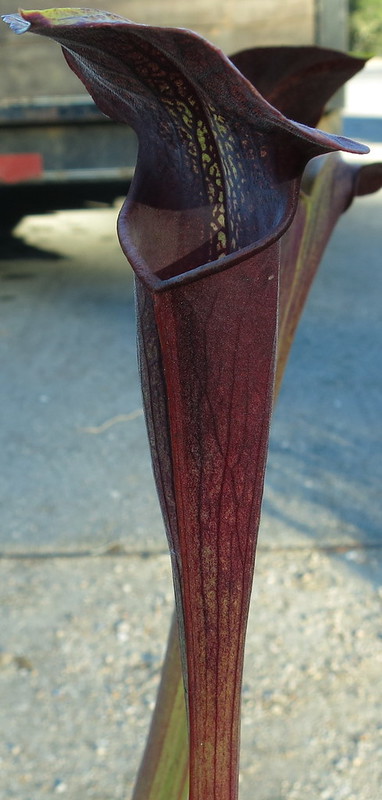
In the wild, they definitely can get pretty dark as the traps age, but you don't see such a high frequency of dark alatas in cultivation. As an aside, I've bred with many "proven" black alata clones only to find the offpsring are generally not as impressive. Some selfed plants (ie. selfed alata 'Night') looked quite impressive greenhouse grown, but they still don't color up easily outdoors. Anyways, the pics below are from wild plants growing in Stone Co, MS:
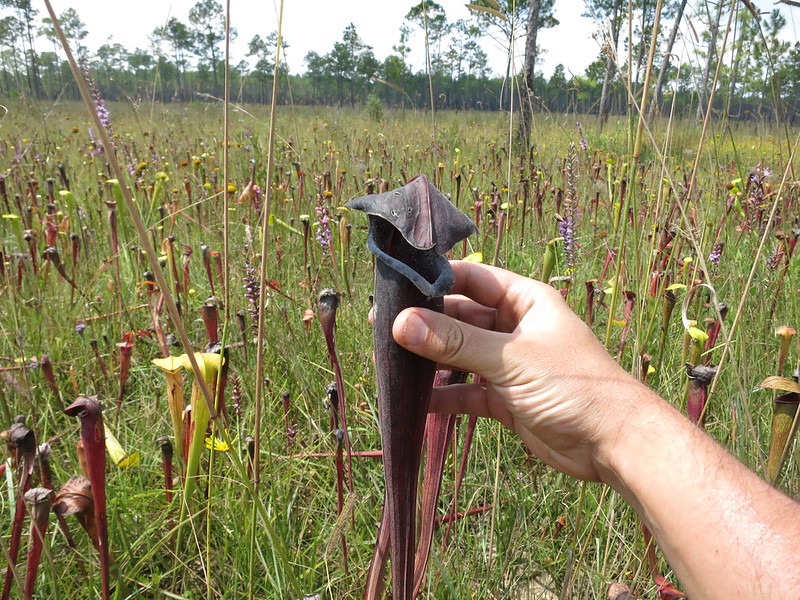

Previously, the closest thing I've personally grown that gets really dark without a greenhouse suntan is Phil's Faulisi's Black Widow:
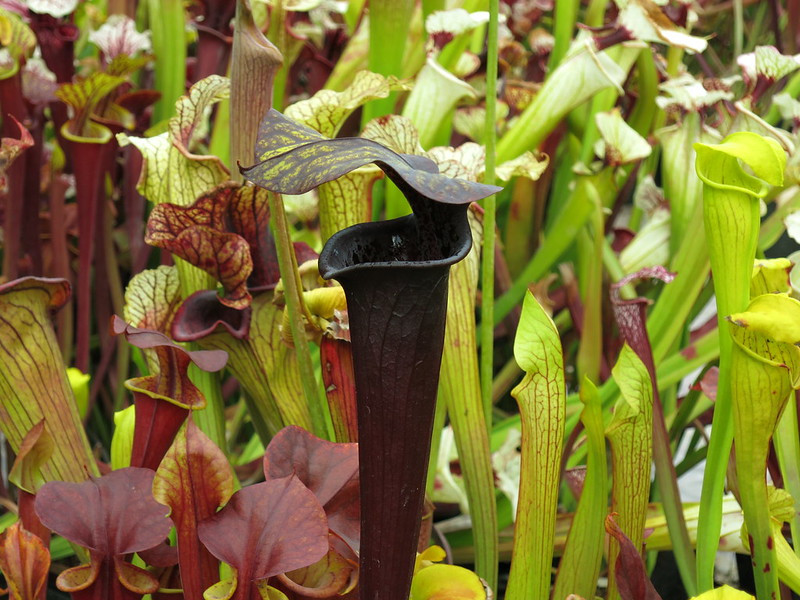
Honorable mention shout out to Rob Sacilotto's S. 'Tornado'(aka S. 'Vortex') There are also pictures online of some black flava x alata crosses made by insektenfang.com, but since the pictures are clearly copyrighted, I'm not going to copy them in this thread. That hybrid appears to have a very black head, but the body is dark red. I'm very confident these were greenhouse grown plants, and they appear to be as dark as some of the black alatas grown under greenhouse conditions.
For those of us without greenhouses, are there any individual plants out there that turn black even under outdoor conditions? I'm not aware of any non-man made plants like that.
Logically, there has to be a way to make a completely black plant from head to toe using flava rubricorpora and the dark alatas, so that's what I did. Black widow is really cool, but I want blacker! LOL
I made several small batch crosses with many different clones in search of that black individual. By small batch, I mean I sowed between 30-50 or so seeds per batch. Surprisingly, most were duds: while the plants were pretty and many were bright red, none were black, so I tossed every last cross out. In one cross, I did get a few darker indivduals, but not darker than black widow. GAH!!!! Phil either got lucky or did a lot of pheno hunting to find black widow. Anyways, Next thought was, what if I grew out over a 1000 seeds, will that one black individual appear? Those black genes have to be there somewhere, maybe it's just a numbers game. But it's not practical to grow out 1000 of each cross, that could take up a lot of space very quickly and become impractical.
I decided to focus on one cross that had dark individuals and re-made it the following year, producing an enormous seed batch. If a few dark ones showed up in 50 seeds or less, will that one black one show up in 1000?
It was a ridiculous amount of work transplanting seedlings and culling lighter colored individuals. No, I didn't grow them all the way out (don't have space and time for that), I did massive cullings and selected out the darkest ones.
With a combination of an educated guess and the power of numbers, I finally found that one individual that I was looking for! Interestingly, NOT A SINGLE OTHER PLANT in the super sized seedling batch was as dark as this individual! There were some that I suspect could probably get blacker with an artificial suntan, but I was looking for the one that gets black under multiple environmental conditions. There were other individuals that came close in terms of blackness, but I culled them to make sure imposters don't go into circulation. Speaking of imposters, this is the reason that I'm not giving out exact details about the clones used in this cross, but in general, flava rubricorpora and alata were used, just like in Phil's black widow cross.
Perhaps the beans are being spilled quite early as this plant is still a seedling, but after you see the pics below, you'll probably agree that this individual is already outstanding. In case you haven't already read this thread about seedling selection and want to dig deeper, I recommend reading this: http://sarracenia.proboards.com/thread/ ... -selection
This un-named clone below doesn't start off black: the traps really have to age before it gets to this color. This plant was naturally grown outdoors in Northern California, and quite possibly represents one of the first of its kind that can get black from head to toe without an artificial greenhouse suntan:
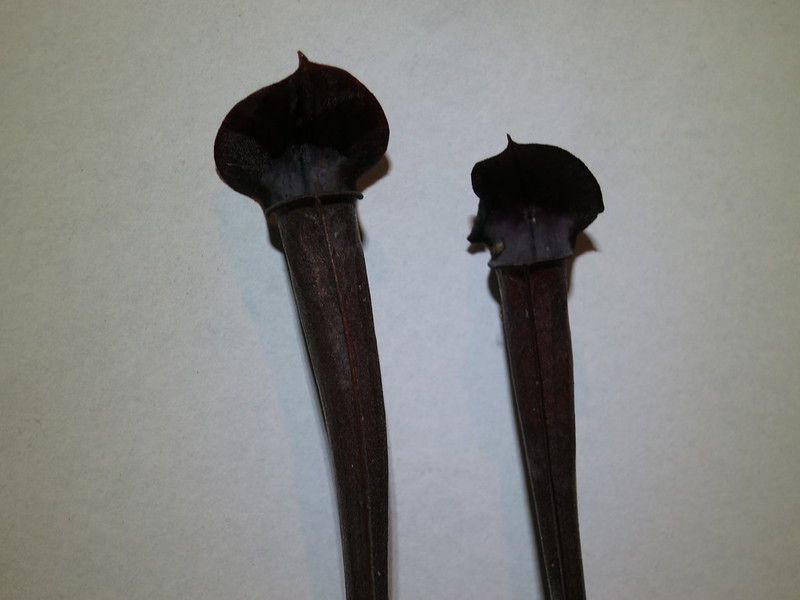
In case you want to zoom in to see the details of the pic above: https://www.flickr.com/photos/63000221@ ... ateposted/
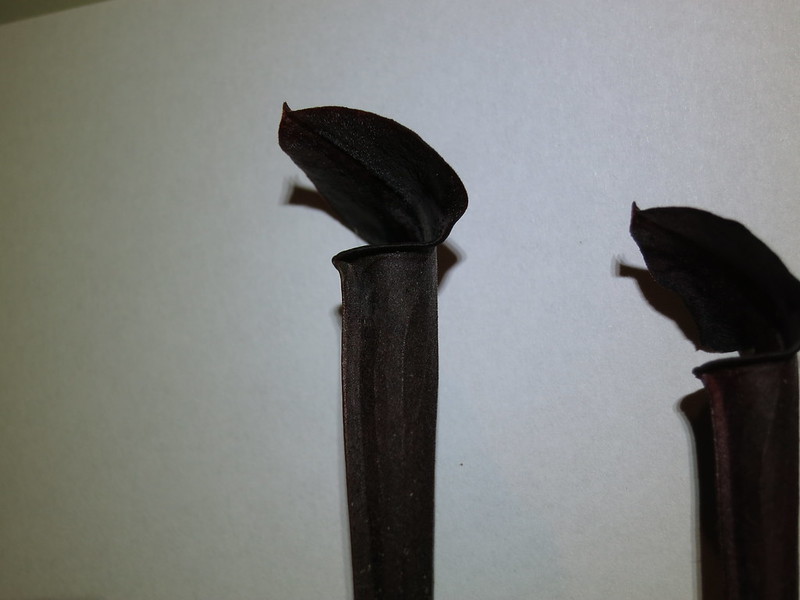
and if you want to zoom in: https://www.flickr.com/photos/63000221@ ... otostream/
The whole dang thing is black:

Another shot: notice some of the younger, smaller traps still have some greenish pigments on the lid:

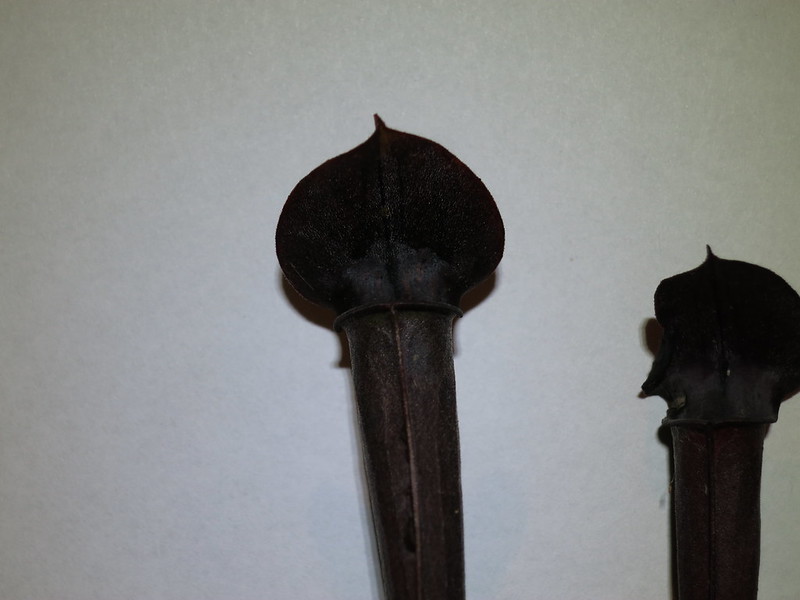
In case you want a close up of that last pic: https://www.flickr.com/photos/63000221@ ... otostream/
This is still a seedling, so again, I may be spilling the beans a bit early about it. For this reason, it won't be named or go into circulation until it reaches vegetative maturity and has been throughly "explored." Who knows, something better might turn up in the meantime. To be continued....
SARRACENIA FOR SALE: http://www.flytrapcare.com/phpBB3/sarra ... 18602.html
SARRACENIA FORUM: http://sarracenia.proboards.com/index.cgi
email me: meizzwang@gmail.com
SARRACENIA FORUM: http://sarracenia.proboards.com/index.cgi
email me: meizzwang@gmail.com



